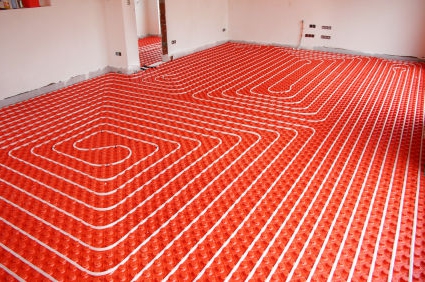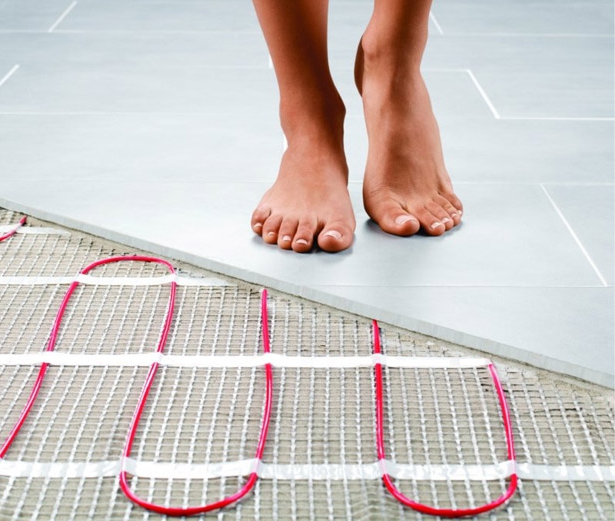It is very nice to walk barefoot on a heated stone or lie on the warm sand. So why, being protected from the cold, are people forced to walk in slippers at home? This is optional, since there are underfloor heating.
Therefore, the question of how to choose a warm floor is currently quite relevant. They are installed not only in the kitchen, bathroom or toilet, but also in country houses. This is due to the distribution of heat throughout the entire room. Not so long ago, only the rich could afford such a luxury, but now the situation has changed.
Such a wonderful device has been familiar to mankind since ancient times. Previously, they were installed in city baths.
The benefits of underfloor heating

With the heating system, which is located at floor level, warm air rises and cools slightly at the level of human growth. With conventional radiators, the ceiling will be hot, but the legs continue to freeze. Therefore, such a system that correctly distributes warm air throughout the room is much more convenient.
Its main feature is a temperature of about thirty degrees, which provides protection against colds. Sitting and lying on such a floor is pleasant, as well as useful, since it warms a person's sides and back. Another benefit: parts of the heating system are hidden in the floor structure, and the air in the room does not dry, because the pipes with hot water or the cable do not come in contact with the atmosphere.
Underfloor heating: which is better to choose?

First you need to decide what type of floor is suitable in a particular case. Knowing the main characteristics of such devices, it will not be difficult to choose a warm floor for the tile. These systems come in two forms.
The first is water floors. In this case, heating is achieved using hot water. They are connected to central heating. Most often, such a system is used in multi-storey apartment buildings. Its design is a combination of serpentine pipes. Connection and installation are quite simple. But there is a small minus, which does not depend on the system, but on the pressure of hot water inside the house.
The pressure in the pipes of apartment buildings is sometimes not so strong as to “push” hot water under the floor. This means that such heating will not work.
Things are much simpler in private homes. The water floor system here will work one hundred percent. In addition, you can fully control the temperature of the carrier, which is difficult to do in apartment buildings. Experts will tell you which company to choose a warm floor.
Installation
The floor is usually mounted on a concrete base, but it is recommended to install waterproofing materials under the pipes so that the heat does not partially go into the heat of the floor itself. Insulation must be put on the base.
After these manipulations proceed to the installation of pipes. So that floor materials do not create pressure on the structure, they should be covered with a concrete screed. The rest of the process, which relates to the laying of flooring materials, will correspond to the laying technologies of the selected coating.

The second type - electric floors - can be mounted absolutely in all rooms, no restrictions exist. Many people wonder which manufacturer to choose a warm floor and how it will behave in wet rooms.
You should not worry about this - the system has passed a large number of various tests that have proved their suitability even in such conditions.Therefore, there are no problems when laying it under a tile or laminate. A huge plus is that such an electrical system can be operated all year round, and it is easy to control the thermal regime.
In this version of electric underfloor heating there is a very pleasant moment - it can be adjusted. It is possible to set a mode in which at the time necessary for a person his work will begin.
disadvantages
It heats up quickly enough, this is, firstly. It would seem that this, on the contrary, is an advantage, but sudden changes in temperature act negatively on some types of floor materials - they are deformed. Therefore, before installing it is better to spend time searching for information and consult with experts on how to choose a warm floor.
Secondly, such electric floors are more expensive than water. Yes, and now electricity is constantly getting more expensive, which can "hit" the wallet. For this reason, before choosing an electric underfloor heating, it is worth weighing everything carefully.
How to choose a warm floor. His views
The system is divided into several groups, everything will depend on the heating element. It is infrared and ordinary.
Typical is a heating cable that connects to the distribution panel. It heats the base of the floor and transfers its heat to the floor material, which allows you to completely warm the room. This type is divided into two subgroups: matte and cable.
The difference between matte is that it is thinner than cable, and the heating element is glued to a special grid. Matte elements are quite simple to install, they are put on glue, deployed in the form of a roll.
Infrared floors are more modern. They emit rays passing through a large number of materials. In this case, the basis of the heating element is graphite. Such a system can be rod and film.
Installation
Even before pouring the concrete screed, it is necessary to lay the heating cable, under which the insulation is placed. The configuration of the room itself does not matter for this option, more important is its proper installation. If it is planned that the room will be very warm, then it must be laid often. The electric mat is laid on a ready-made screed if it is planned to install ceramic tiles on the floor. In the case of laminate, linoleum or carpet, the mat must be filled in with a thin layer of adhesive.
Developer Tips
It is impossible to say unequivocally which manufacturer to choose a warm floor. But, of course, it is better to give preference to well-known companies (for example, Devi, Teplolux). These companies provide only truly high-quality devices, and also give a guarantee on their products, so you can safely buy just that. There are domestic manufacturers on the market that offer reasonable prices and high quality. They are constantly improving developments to cater to potential buyers.
Properly used and properly installed flooring will perform its technical tasks well. The same applies to its value. Installing an electrical system on the area of the house will be cheaper than water. But the second type in the future will require less cost, especially if it will be constantly used. Having learned what types of floor there are, their cost, as well as the installation feature, a person can easily figure out how to choose a warm floor.
Basic selection rules

Many people wonder: how to choose a warm floor? This is a very responsible question, so the following points should be considered:
- Type of room. All types of heating systems have features. Some of them are intended for a loggia, a balcony, kitchen, and others for rooms.
- Localization.The design may significantly differ systems that are mounted in several rooms at once, and those that heat only a specific area.
- Type of coating. Installation can be carried out under a different coating - tile, laminate, linoleum and so on. Therefore, it is very important to consider this factor.
- Properties of electrical wiring - the engineering system must withstand voltage.
Pay attention to the presence of rooms with glazing, as well as the number of storeys of the room.
Conclusion

When choosing a warm floor, people are most often guided by their own understanding of comfort and reliability, but this is not entirely true.
At the time of purchase of such a heating system, it is imperative to listen to professionals.
When using this design, it is very important to observe safety precautions.
The heating system based on the electric cable must be earthed in accordance with all standards. This will protect all residents of the apartment from unnecessary electric shock.
Quite often, underfloor heating is installed under the tiles in bathrooms, where humidity is constantly high. Additional precautions are needed here. For example, the remote control from the thermostat must be moved outside this room.
Having thoroughly studied this issue, having weighed the pros and cons, cons, pluses, and tips of specially trained people, a person can easily make the right choice.